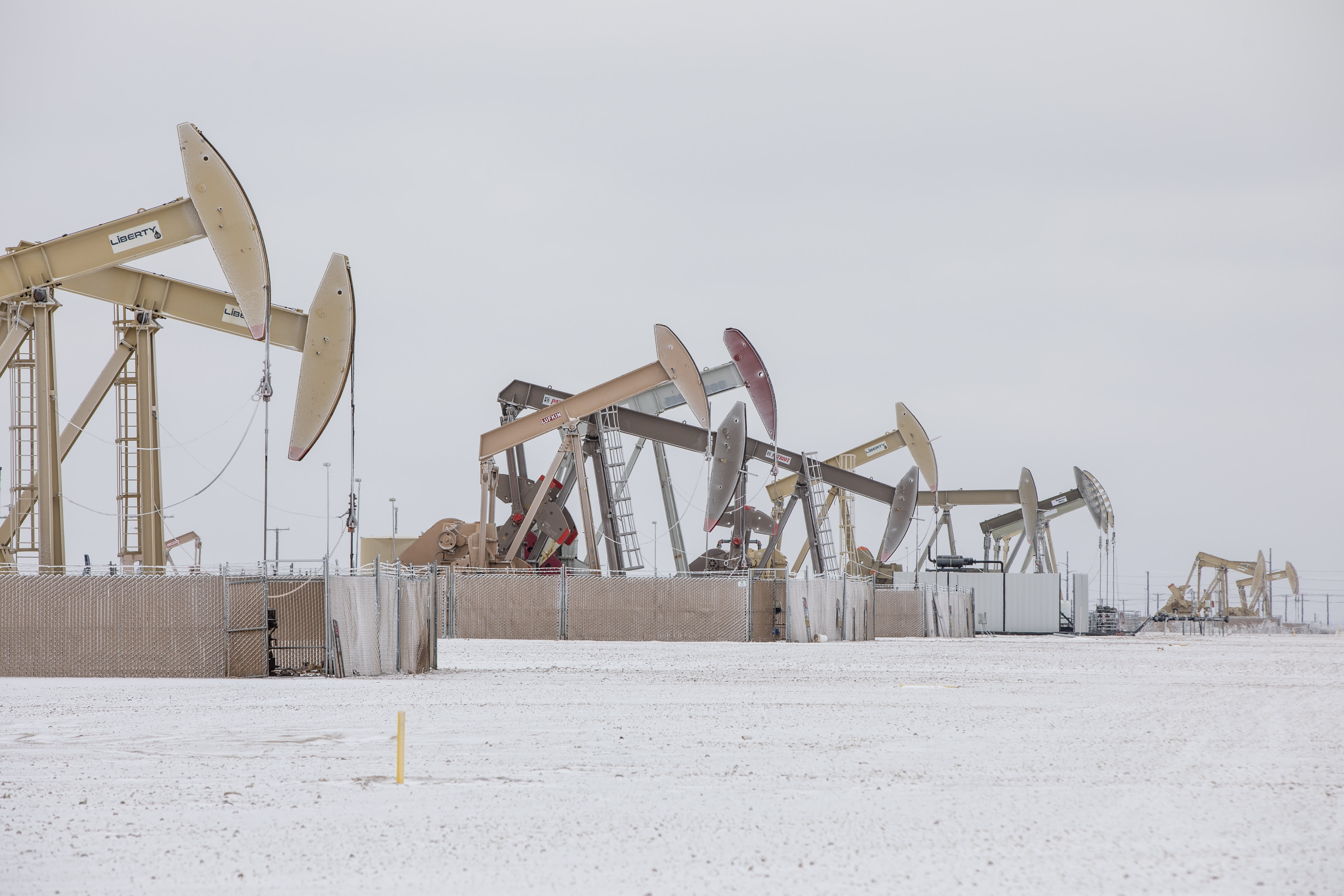Pump jacks operate in the Permian Basin in Midland, Texas, U.S, on Saturday, Feb. 13, 2021.
Matthew Busch | Bloomberg | Getty Images
The shock winter storm in Texas that left millions without power and took dozens of lives also froze a major local commodity: the Lone Star state’s oil production, slashing some 4 million barrels per day from U.S. output.
The consequence will be a boost in revenue and potentially increased exports among rival oil-producing nations, commodities experts say.
Analysts estimate the total volume of oil lost to Texas’ production freeze at anywhere between 18 million and 40 million barrels and roughly one-fifth of U.S. refining capacity was shut in. And while temperatures are moving upward again and production is expected to mostly recover by the end of this week, the impact of the deficit on oil markets is already visible in the recent jump in crude prices.
International benchmark Brent crude is up more than $6 per barrel since the storm began hitting Texan production facilities in mid-February. U.S. benchmark West Texas Intermediate has risen about $3 per barrel.
The development, while adding yet another blow to Texas on top of the devastating damage and human suffering wreaked by the once-in-a-decade storm, translates on the global market into a likely boon for other oil producers, like those in the Middle East.
“The Texas storm helps Saudi and its partners tremendously because it accelerates the path to inventory normalization,” Peter Sutherland, president of Houston-based energy investment firm Henrietta Resources LLC.
“Concurrent drawdowns of both crude and refined products are a big tailwind heading into spring,” he told CNBC. “It’s not just positive sentiment; the roughly 40 million barrels lost due to the storm help tighten the market.”
OPEC expected to increase production
The inventory drawdown continues a trend that’s seeing oil prices steadily rise from their historic pandemic-induced lows nearly a year ago. Brent crude is up 30% year to date, with Goldman Sachs predicting it could hit $75 by the end of this year, a level not seen since fall of 2018.
This could influence decision making among OPEC members in their upcoming meeting on March 4. While the organization had prioritized production cuts during much of the pandemic to keep a floor under oil prices, the more promising outlook for demand — and gradually normalizing global supply — provides incentive for these producers to speed up the rate at which they’ll increase their production.
“I would certainly expect Saudi Arabia to boost production given the current prices that the market has seen,” said Yousef Alshammari, CEO at oil markets consultancy firm CMarkets.
“Supply disruption in Texas may lead to OPEC+ and Saudi Arabia to raise production by a certain extent and much of that production rise will go to exports at higher prices.” OPEC+ is the loose alliance of 13 OPEC states and 10 non-OPEC oil producing countries.
Saudi Arabia’s voluntary production cuts of 1 million barrels per day ends in March, and is already expected to start gradually bringing back supply in April. But that also means the kingdom can’t take advantage of higher crude prices by ramping up exports until that production cut period ends.
Still, “every oil producer, including Saudi Arabia, enjoys the benefit of” the price increase, said Tamas Varga, senior analyst at PVM Oil Associates. “U.S. crude oil exports will fall in coming weeks and this provides support for international grades — again supportive for oil producers.”
‘Very small on a global basis’
Some analysts don’t see the Texas output loss as consequential, even in the medium term.
The impact of a 4 million barrel daily loss “is very small on a global basis as the world produces over 80 million barrels per day of oil,” Rene Santos, manager for North America supply at S&P Global Platts Analytics, told CNBC.
“Freeze-offs happen in the U.S. every year but of the magnitude that we experienced in the past few days does not happen very often,” he said. “In addition, freeze-offs are short-lived.”
PVM’s Varga agrees. “The situation will likely normalize soon and in the medium-term the impact of the Texas freeze will be negligible, I think,” he said.
But the longer-term market dynamic is still in OPEC members’ favor — not because of Texas’ storm, but thanks to last year’s devastating oil production shut-ins across the U.S. when crude prices crashed. The high cost of U.S. shale production meant most producers couldn’t survive the impact of the lockdowns. U.S. rig count is still 50% below 2019 levels, despite climbing prices.
“U.S. oil production is not expected to rebound to 2019 levels which will leave OPEC+ with much more influence on the markets in 2021,” Alshammari said.
Over the long term, the impact from a weather shock like this month’s “really depends on how Texas will deal with such crises in the future,” he added. “I expect them to be more resilient to such adverse weather conditions on the upstream supply side, yet I certainly expect Saudi Arabia to have a bigger market share in the long run due to the lost market share from shale production.”
